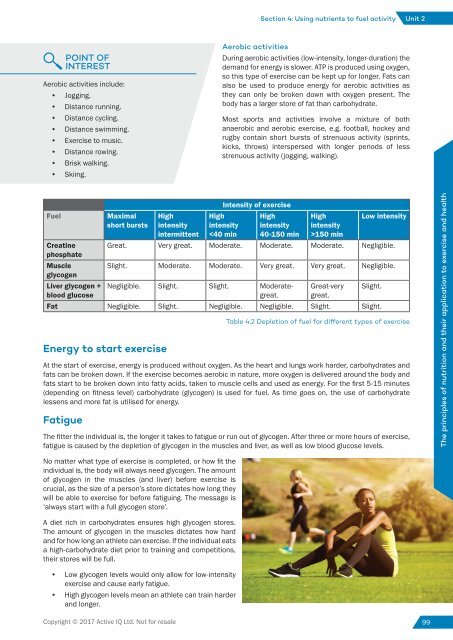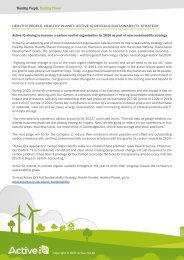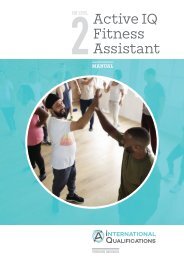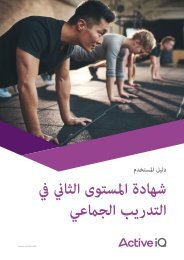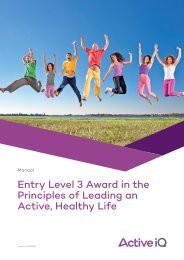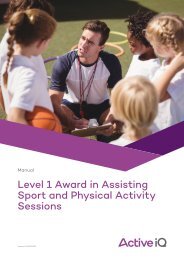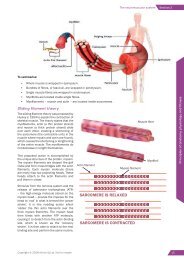Active IQ Level 3 Diploma in Personal Training (sample manual)
- No tags were found...
You also want an ePaper? Increase the reach of your titles
YUMPU automatically turns print PDFs into web optimized ePapers that Google loves.
Section 4: Us<strong>in</strong>g nutrients to fuel activity<br />
Unit 2<br />
POINT OF<br />
INTEREST<br />
Aerobic activities <strong>in</strong>clude:<br />
• Jogg<strong>in</strong>g.<br />
• Distance runn<strong>in</strong>g.<br />
• Distance cycl<strong>in</strong>g.<br />
• Distance swimm<strong>in</strong>g.<br />
• Exercise to music.<br />
• Distance row<strong>in</strong>g.<br />
• Brisk walk<strong>in</strong>g.<br />
• Ski<strong>in</strong>g.<br />
Aerobic activities<br />
Dur<strong>in</strong>g aerobic activities (low-<strong>in</strong>tensity, longer-duration) the<br />
demand for energy is slower. ATP is produced us<strong>in</strong>g oxygen,<br />
so this type of exercise can be kept up for longer. Fats can<br />
also be used to produce energy for aerobic activities as<br />
they can only be broken down with oxygen present. The<br />
body has a larger store of fat than carbohydrate.<br />
Most sports and activities <strong>in</strong>volve a mixture of both<br />
anaerobic and aerobic exercise, e.g. football, hockey and<br />
rugby conta<strong>in</strong> short bursts of strenuous activity (spr<strong>in</strong>ts,<br />
kicks, throws) <strong>in</strong>terspersed with longer periods of less<br />
strenuous activity (jogg<strong>in</strong>g, walk<strong>in</strong>g).<br />
Fuel<br />
Creat<strong>in</strong>e<br />
phosphate<br />
Muscle<br />
glycogen<br />
Liver glycogen +<br />
blood glucose<br />
Maximal<br />
short bursts<br />
High<br />
<strong>in</strong>tensity<br />
<strong>in</strong>termittent<br />
Intensity of exercise<br />
High<br />
<strong>in</strong>tensity<br />
150 m<strong>in</strong><br />
Low <strong>in</strong>tensity<br />
Great. Very great. Moderate. Moderate. Moderate. Negligible.<br />
Slight. Moderate. Moderate. Very great. Very great. Negligible.<br />
Negligible. Slight. Slight. Moderategreat.<br />
Great-very<br />
great.<br />
Slight.<br />
Fat Negligible. Slight. Negligible. Negligible. Slight. Slight.<br />
Energy to start exercise<br />
Table 4.2 Depletion of fuel for different types of exercise<br />
At the start of exercise, energy is produced without oxygen. As the heart and lungs work harder, carbohydrates and<br />
fats can be broken down. If the exercise becomes aerobic <strong>in</strong> nature, more oxygen is delivered around the body and<br />
fats start to be broken down <strong>in</strong>to fatty acids, taken to muscle cells and used as energy. For the first 5-15 m<strong>in</strong>utes<br />
(depend<strong>in</strong>g on fitness level) carbohydrate (glycogen) is used for fuel. As time goes on, the use of carbohydrate<br />
lessens and more fat is utilised for energy.<br />
Fatigue<br />
The fitter the <strong>in</strong>dividual is, the longer it takes to fatigue or run out of glycogen. After three or more hours of exercise,<br />
fatigue is caused by the depletion of glycogen <strong>in</strong> the muscles and liver, as well as low blood glucose levels.<br />
The pr<strong>in</strong>ciples of nutrition and their application to exercise and health<br />
No matter what type of exercise is completed, or how fit the<br />
<strong>in</strong>dividual is, the body will always need glycogen. The amount<br />
of glycogen <strong>in</strong> the muscles (and liver) before exercise is<br />
crucial, as the size of a person’s store dictates how long they<br />
will be able to exercise for before fatigu<strong>in</strong>g. The message is<br />
‘always start with a full glycogen store’.<br />
A diet rich <strong>in</strong> carbohydrates ensures high glycogen stores.<br />
The amount of glycogen <strong>in</strong> the muscles dictates how hard<br />
and for how long an athlete can exercise. If the <strong>in</strong>dividual eats<br />
a high-carbohydrate diet prior to tra<strong>in</strong><strong>in</strong>g and competitions,<br />
their stores will be full.<br />
• Low glycogen levels would only allow for low-<strong>in</strong>tensity<br />
exercise and cause early fatigue.<br />
• High glycogen levels mean an athlete can tra<strong>in</strong> harder<br />
and longer.<br />
Copyright © 2017 <strong>Active</strong> <strong>IQ</strong> Ltd. Not for resale 99


